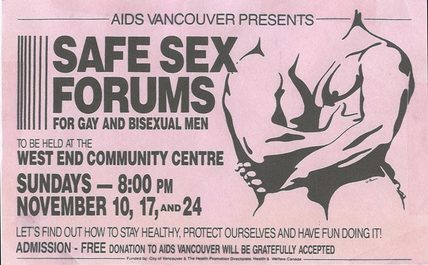 On April 8, in honour of Youth and AIDS Day, the AIDS Activist History Project (AAHP) launched its first exhibition, titled “POSITIVE SEX: Eroticizing Safer Sex Practices in Canada in the 1980s and 1990s.”
On April 8, in honour of Youth and AIDS Day, the AIDS Activist History Project (AAHP) launched its first exhibition, titled “POSITIVE SEX: Eroticizing Safer Sex Practices in Canada in the 1980s and 1990s.”
Hosted by the MacOdrum Library at Carleton University, “POSITIVE SEX” combines powerful excerpts from eight oral history interviews with over thirty pieces of ephemera (including photos, pamphlets, flyers, posters, articles and news clippings) from the AAHP collection. Also on display is a collection of books related to AIDS activism and safer (positive) sex, a selection of erotic, sex-positive and educational materials from CATIE and Venus Envy, and an assortment of condoms (male and female! flavoured and lubricated!) and dental dams donated by the Graduate Students’ Association.
 The aim of this exhibition is to explore how AIDS activists eroticized safer sex practices in the 1980s and 1990s. To activists, eroticizing was both a personal and political intervention. It was a way of pushing back against the dominant, abstinence-based discourse surrounding positive sex– one that stigmatized positive and queer communities while simultaneously erasing their sexual agency. Eroticizing safer sex practices flipped the script: it became a way of refusing to see “sex-crazed, ‘promiscuous,’ bath-going gay men” as a problem and refusing to push for monogamous “politically correct” relationships. It cleared space for “ambiguities and contradictions” as well as for fisting and fingering. It was a way of caring for oneself and others, for friends and fuck buddies, and for people living with HIV/AIDS. Eroticizing safer sex was a personal, political and liberatory effort.
The aim of this exhibition is to explore how AIDS activists eroticized safer sex practices in the 1980s and 1990s. To activists, eroticizing was both a personal and political intervention. It was a way of pushing back against the dominant, abstinence-based discourse surrounding positive sex– one that stigmatized positive and queer communities while simultaneously erasing their sexual agency. Eroticizing safer sex practices flipped the script: it became a way of refusing to see “sex-crazed, ‘promiscuous,’ bath-going gay men” as a problem and refusing to push for monogamous “politically correct” relationships. It cleared space for “ambiguities and contradictions” as well as for fisting and fingering. It was a way of caring for oneself and others, for friends and fuck buddies, and for people living with HIV/AIDS. Eroticizing safer sex was a personal, political and liberatory effort.
In our interviews with AIDS activists, we’ve heard stories of physicians denying patients sexual agency: “You have AIDS. Don’t have sex with anybody. Any questions?” We’ve listened as activists recall
the mainstream discourses that cast queer, positive lives as “abnormal, sick and criminal.” We’ve heard stories of refusal, resistance and community-based education that actually made a difference in people’s lives. AIDS activists reminded one another to “come on me, not in me” while participating in safer sex practices that were wild, erotic and intensely pleasurable.
“We need to say no, we’re finding safer ways and continuing to play.” – Tannis Atkinson, “Wet, wild and well” publication
While “POSITIVE SEX” recalls many of the personal and political interventions made by AIDS activists, this only the beginning of a series of exhibitions to be produced by the AIDS Activist History Project. The memories and experiences that this exhibition brings into view are part of a broader history of government inaction and resistance against the stigmatization and criminalization of people living with HIV/AIDS in “Canada.” Much of our work with this project is to continue uncovering stories of resistance and direct action, and to continue to make these histories available to the public.
 “POSITIVE SEX” will be on display at the MacOdrum Library until May 8, 2016. The exhibition will then move on to Mike’s Place, Carleton’s grad student bar.
“POSITIVE SEX” will be on display at the MacOdrum Library until May 8, 2016. The exhibition will then move on to Mike’s Place, Carleton’s grad student bar.
To view the full exhibition online, click here or visit the “Exhibitions” tab above.
Connect with us on Twitter (@AIDSHistory) using the hashtags #eroticize and #PositiveSex. What does eroticize mean to you? Join in the discussion!